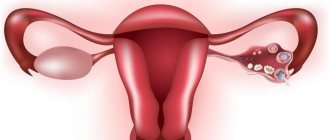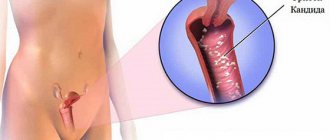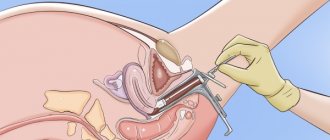A huge number of microbes and bacteria live in the human body. They inhabit the skin, mucous membranes, intestines, and in women, the reproductive organs and vagina. They can be beneficial or pathogenic when in balance. Treatment for pathogenic microorganisms is prescribed, after which suppositories are used to restore the vaginal microflora.
For various reasons, it happens that the balance is disturbed, the number of pathological organisms increases, and a complex biological system fails. If the vaginal microflora is disturbed, vaginal dysbiosis or dysbiosis occurs, when it is necessary to take measures to restore the microflora.
Composition of microflora, causes and signs of dysbiosis
Healthy vaginal microflora has the majority (90%) of lactobacilli and about 9% of biphylobacteria. Opportunistic organisms occupy the remaining part of the flora. They are called opportunistic because their number increases under certain conditions.
Such a small number of them (about 1%) rarely causes female diseases, since lacto- and bifidobacteria successfully fight them, especially with healthy immunity. But with a decrease in the number of beneficial bacteria, there is an increase in harmful fungi, chlamydia, streptococcus, gardnerella and others, in which the microflora is disturbed.
Provoking factors for microflora imbalance are:
- anatomical features of the female reproductive system;
- hypothermia, which reduces immunity;
- altered hormonal levels - during pregnancy, menopause, after abortion, childbirth, menstrual irregularities;
- climate change;
- stress;
- change of sexual partners without protection;
- inflammation, infections of the reproductive and urinary systems;
- condition after treatment of female diseases;
- taking antibiotics;
- intestinal infections;
- improper use of tampons;
- failure to maintain intimate hygiene.
At the initial stage of the disease, signs are not always possible to determine; they may simply be absent. As the disease progresses, you may experience:
- discharge of a different nature and color - white, yellow, greenish, having varying thickness, curdled;
- smell of discharge;
- discomfort in the groin area;
- vaginal dryness during sex;
- pain and itching in the labia area;
- itching and burning when urinating.
The symptoms themselves are not dangerous, but the infection can affect the cervix and progress further to affect the uterus, fallopian tubes and ovaries. Symptoms should be alarming and be a reason to contact an antenatal clinic.
Symptoms and diagnosis of the disease
Quite often, vaginal dysbiosis occurs without symptoms. In some cases, the following signs of the disease may be observed:
- copious yellowish-white discharge;
- unpleasant odor;
- feeling of dryness, itching and burning in the perineum.
The symptoms themselves are not dangerous, but the bacteria can infect the cervix and vagina.
In order for a doctor to diagnose dysbiosis, the patient will have to undergo several types of tests:
- PCR diagnostics for the presence of sexually transmitted infections;
- culture for sensitivity to antibacterial drugs;
- microflora smear.
Based on the test results, the cause and treatment methods for dysbiosis can be determined.
How to eliminate dysbiosis
It is necessary to restore the microflora due to the anatomical features of the female genital organs. Closely located urinary tract and intestines contribute to the penetration of their infection into the vagina. If the number of beneficial bacteria is normal, they fight the foreign environment, suppressing it.
Treatment to restore vaginal flora is divided into three stages:
- Eliminating the cause of the disease, fighting the virus or fungus that caused the disease;
- Strengthening immunity;
- Restoration of lost vaginal microflora.
After you have cured the underlying disease and strengthened your immune system, you need to restore the normal healthy environment of the genital organs. For this purpose, suppositories are suitable for restoring the vaginal microflora.
Vaginal suppositories are probiotics, used after drug treatment, after thrush, after cervical erosion to regenerate the vaginal walls. It is necessary to restore the walls of the vagina, since with any infection of the genital tract, as well as its treatment, the vaginal epithelium dies. Vaginal suppositories help restore the epithelium.
Treatment of vaginal dysbiosis: folk remedies
Video about vaginal microflora disorders. Source - Makarova Mama
Classical medicine offers a program for restoring vaginal microflora, consisting of three steps:
- elimination of bacteria that cause microflora disruption;
- direct restoration of vaginal microflora;
- restoring the immunity of the vaginal wall so that healthy microflora is maintained in the future.
First, the doctor will prescribe tests. It is important that both partners undergo the tests prescribed by the gynecologist. This will further help identify the cause of dysbiosis. In addition, if the cause was a sexually transmitted infection, this will help prevent re-infection of the partner.
If the cause is truly a sexually transmitted infection, the causative agent of the disease must be eliminated. In this case, you cannot do without a course of antibacterial therapy, that is, taking antibiotics. The following drugs are usually prescribed: Sumamed, Trichopolum, Amoxiclav, Doxycycline, etc.
If genital infections have not been detected, then taking antibiotics is not necessary. You can not use antibacterial therapy, or take a very short course - no more than 5 days.
Next, it is imperative to carry out local procedures, the effectiveness of which can hardly be overestimated. For this purpose, classic medicinal tampons and baths are used. These procedures are carried out comprehensively. They suppress pathogenic microflora, restore healthy ones and correct local immunity. In this case, antiseptics are used. The best antiseptic in this case is Miramistin.
When the cause of the microflora disturbance is detected and eliminated, it is time to restore normal microflora.
You can try to restore the flora using folk remedies. However, if you decide to try them, be sure to consult with your gynecologist: the doctor should know what measures you are taking to be cured. Only after the doctor’s consent can you safely begin the procedures. What does traditional medicine offer women in such cases?
- medicinal tampons. You can make your own tampons from cotton wool and gauze, or you can take ready-made hygienic ones and soak them in honey and kefir. Before doing this, be sure to make sure that you are not allergic to honey. It is necessary to alternate tampons: do one with honey, another with kefir, and so on. The course of treatment lasts 10 days;
- sea buckthorn oil. As in the previous option, take a tampon, soak it in sea buckthorn oil and leave it overnight, and remove it in the morning. The course of treatment also lasts 10 days;
- medicinal chamomile. Prepare the infusion: 1 tbsp. l. chamomile flowers pour 2 tbsp. boiling water Strain the infusion and use for douching. The procedure must be carried out every evening with a warm solution. The course lasts 10 days.
Courses can be repeated, but between each of them it is necessary to take a break. Procedures are not performed during menstruation.
Preparations to improve vaginal microflora
The principle of operation of vaginal suppositories with lactobacilli is simple: it consists in increasing the number of beneficial lactobacilli and biphylobacteria. They restore the acid-base level to pH 3.5-4.5. The acid produced by lactobacilli, as well as the excipients of suppositories, help fight harmful microorganisms in the vagina.
Vaginal suppositories with bifidobacteria have an anti-inflammatory effect and improve immunity. As a result, the development of a pathogenic environment accidentally introduced from the outside does not occur; its reproduction will be stopped by our beneficial bacteria.
It is good if the drug contains lacto- and bifidobacteria together, in which case their complex interaction will accelerate the effect of treatment.
Vagikak (Vagikal, Laktogin)
It has a gentle effect on the vaginal walls, suppresses pathogenic microorganisms, and prevents their development and growth. Contains calendula flowers, a natural remedy for inflammation. Suppositories are an antioxidant, perfectly heal, restore the cellular epithelium of the vagina. The course of treatment is 10 days.
Bifidumbacterin
The suppositories contain bifidobacteria, which cure vaginal dysbiosis and also suppress the growth of pathogenic intestinal flora. Treatment lasts 5-7 days, suppositories are used 2 times a day. The drug is not dangerous and can be used by pregnant and lactating women.
Gynoflor
To restore microflora, they contain lactobacilli, and also contain the hormone estriol and lactose. Estriol promotes the restoration of vaginal epithelial tissue, and lactose helps beneficial microorganisms actively reproduce. The drug is harmless, it should be used for 7 days, if necessary, the course can be increased to two weeks. After two weeks, the course of treatment can be repeated.
Lactozhinal
Suppositories to improve vaginal flora. Administer while lying on the bed before going to bed. Often used after treatment of candidiasis. Use 1 suppository in the morning and evening for 7 days, or 1 suppository at night for 14 days.
Vaginorm S
Contains ascorbic acid, inhibits the growth of microbes, normalizes vaginal pH. The course is 7 days, suppositories must be administered at night, this is done for 6 days, if necessary, can be extended to two months.
Kipferon
Vaginal and rectal suppositories, a complex preparation, increases the immune cells of the vagina and intestines, restores the vaginal and intestinal environment. Treatment lasts 10 days; complete cure requires 2-3 courses; in between, microflora smears are taken.
Suppositories for topical use, the best suppositories for women, who are very fond of being prescribed in gynecology. Has no side effects, highly effective.
Acylact
Suppositories can be used in antibiotic treatment; they interact well with other medications.
All vaginal suppositories containing lactobacilli and bifidobacteria are recommended for use after antibiotic therapy, since beneficial acidophilus bacteria can be destroyed by other medications. Read the instructions carefully.
When not to use candles
Despite the fact that suppositories for the treatment of flora are used very often in gynecology, they are not dangerous, it is better to consult a doctor before use. Suppositories themselves have no side effects, but every woman’s body has individual characteristics. When candles are not used:
- with hypersensitivity to the substances of the drug;
- with cancer of the uterus, vagina, ovaries or suspicion of them;
- with a diagnosis of endomitriosis;
- with uterine bleeding of various origins;
- with untreated endometrial hyperplasia;
- girls who have not yet begun their sexual life.
Some people may develop an allergy when using it, which will also have to be treated. If you are intolerant to the components of the suppositories, the amount of discharge may increase, and itching and burning in the labia area may occur.
What types of vaginal discharge there are and how to choose the right treatment is explained in detail by gynecologist Irina Viktorovna Zhgareva. Anyone can listen to and watch a lecture by a certified doctor with experience without leaving home.
Sometimes it makes sense to carry out preventive treatment at least once a year, then the risk of genital infection is reduced to zero. Your life, including your sexual life, will change for the better because there will be at least one less problem.










